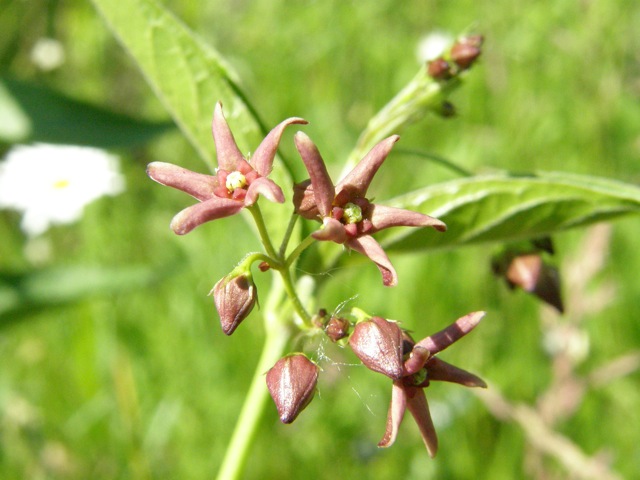Apocynaceae, the Dogbane family. (Greek, Dog-strangler) formerly Asclepiadaceae, the milkweed family
******
Description:
Plant:
Recumbent or climbing plant, 3'-6' tall, smooth to slightly downy, with opposite leaves,
and clusters of small brownish or blackish flowers growing from the leaf axils.
Perennial.
Flowers:
Reddish brown to blackish purple, about 1/4" across, five petals, five sepals, with a classic
milkweed "crown" structure in the center. In small clusters (cymes) containing 10-30 blossoms,
that arise from the leave axils.
Leaves:
Opposite, ovate, 2"-4" long, with short "dogleg" petioles that rise parallel to the stem for a
short distance and then bend sharply outward to the leaves.
Fruit:
Clusters of narrow, pointed pods, 2"-3" long, that open and release seeds bearing many long,
silky hairs which serve as a dispersal mechanism.
Blooming:
May-July
Habitat:
Thickets, clearings, moist open woods with sun penetration.
Comments:
This member of the milkweed group is an aggressive import from Eurasia.
It often grows in dense stands that can crowd out native species.
The generic name means "dog strangler" in Greek, in apparent reference to a similar
plant that was reputedly poisonous to dogs.
The plant is classified with the milkweeds, which have recently been made a
subfamily of the dogbane family (apocynaceae)
Where to find it:
Uncommon in the park as of 2009, I have seen it in only two locations, one along the pond
trail on the north side of the east arm, and the other near the northwest park boundary
near between the small pool and the parking lot.
Given the aggressiveness of the species, this may not always be the case.
